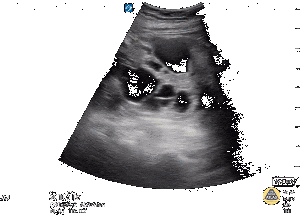Polycystic kidney disease
Background
- Multisystemic and progressive disorder resulting in renal cysts and renal enlargement
- Hereditary disorder, autosomal dominant
- Accounts for ~2% of new cases of renal failure each year
Mortality
- Cardiovascular
- Infection, septicemia
- Subarachnoid hemorrhage
- Uremia
Clinical Features
- Clinical presentation typically begins in 3rd to 4th decade of life, but may be detectable in childhood
- Abdominal pain, flank pain and/or back pain is most common initial symptom.
- Pain due to:
- enlargement of cysts
- bleeding within cyst or gross hematuria with clots or perinephric hematoma
- urinary tract infection
- nephrolithiasis
- Pain due to:
- Hematuria
- self-limited
- cysts are susceptible to traumatic injury
- Hypertension
- common early manifestation
- increased diastolic
Differential Diagnosis
Evaluation

Bedside ultrasound shows multiple renal cysts consistent with patient history of PKD[1]
- Renal ultrasound is the imaging of choice
- CBC, BMP
- Urinalysis +/- Urine culture
Management
Disposition
See Also
References
- Torra R et al. Polycystic Kidney Disease. eMedicine. Feb 11, 2016. http://emedicine.medscape.com/article/244907-overview#showall
This article is issued from
Wikem.
The text is licensed under Creative
Commons - Attribution - Sharealike.
Additional terms may apply for the media files.